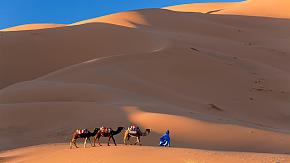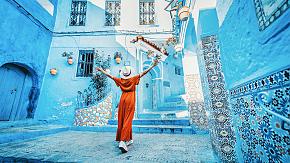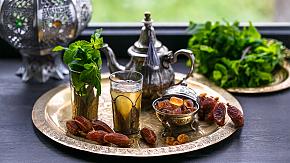Taking a Trip to Tangier in Morocco
Morocco (المملكة المغربية) is the only African country which has a Mediterranean and Atlantic coastline. Today, we are going to look at the point where the Mediterranean meets the Atlantic just opposite Spain and Gibraltar.
TANGIER (طنجة)
If you see her, say hello
She might be in Tangier
She left here last early spring
Is livin' there, I hear
- Bob Dylan
When Nobel prize winner Dylan wrote his achingly sad message to an anonymous lost love, with whom the narrator had "a falling-out", he was following a long line of artists, writers and musicians who have been inspired by the fabulous city of Tangier, but also referencing that the city is a mysterious place in which secrets are whispered and people can hide. The French Romantic painter, Delacroix was enthralled by the city and left behind around 80 oil paintings of Tangier scenes. Matisse, too spent time here. Writers galore have visited or even lived here, including George Orwell, Tennessee Williams, Jean Genet, William Burroughs, whose The Naked Lunch was written and set here, Allen Ginsberg and Jack Kerouac and more. American writer, composer and translator Paul Bowles came to the city in 1947 and lived there until his death 52 years later. In 1990, Bowles' The Sheltering Sky was made into a movie by great Italian director, Bertolucci - some scenes were shot in Tangier.
So what attracted all these famous people? They all had their different reasons for coming, of course, but high on the list were the climate, the international nature of the city, and its reputation for being easy-going and tolerant. It helped too that Tangier was easy to access by ferry from Europe in the days before mass air travel.
 The coastal view of Tangier
The coastal view of Tangier
Tangiers was founded by the Phoenicians between the 10th and 8th centuries BC, taken over by the Berbers around the 6th century BC, then by the Carthaginians in the 5th century BC. Later the Romans incorporated it into their empire. With the fall of the Roman empire, the city fell into the hands of the Vandals for some time before becoming part of the Byzantine empire. Later again control returned to the Berbers, only to be lost in 1471 to the Portuguese, who ruled until 1661 when they lost it to England. The English ruled until 1684 and rule passed to Morocco. In 1912 Morocco was partitioned by the French and Spanish, with Spain taking control of Tangier. This changed again in 1923, when the city was declared to be an international zone administered jointly by France, Spain and Britain. This arrangement was interrupted in 1940 when Franco's Spain invaded the city, but after the War the international zone was reinstated, lasting until 1956 when Tangier rejoined the newly independent Morocco as a fully Moroccan city. Feeling dizzy?
During the international zone period, Tangier was known as spy central. In the 1960s and 1970s the city garnered a somewhat seedy reputation for decadence, crime rose and the number of visitors fell, preferring Marrakesh or other Moroccan cities, which were now more accessible through cheap flights from Europe. However, beginning in 2010, with the strong support of King Mohammed VI, the city began to restore itself, by improving the infrastructure and cleaning up its act in general. The beach front area was completely cleaned and new cafés and other facilities installed. Today, the number of tourists is on the rise again. So, what is there to do and see?
TANGIER KASBAH
Let's start at Tangier's Kasbah, a walled citadel sitting on top of a rocky outcrop at the highest point of the city. Entering through Bab Kasbah, an imposing gate, you will find yourself in a maze of lanes and alleyways with beautiful white and blue painted homes, schools, shops, cafés and other businesses. Strolling at random, you will come across souks (markets) selling everything one could need for everyday life. You can also find some souvenirs here, too. Within the Kasbah is Dar El Makhzen, which was formerly the Sultan's Palace. Today, the 17th-century palace is home to Kasbah Museum of Mediterranean Cultures, which presents the history of this area from ancient times up to the 19th century. Exhibits are labeled in Arabic and French only, but even if you know nothing of those languages, the museum is well-worth visiting. The most important exhibits include a mosaic of Venus found in Volubilis, Morocco's finest Roman town archaeological site, and a 12th-century map showing what was then the known world. Also here is a lovely Andalusian garden. But for me the highlight of the Kasbah is simply to walk around soaking up the atmosphere and seeing the local people going about their lives.
The museum is on Place de Kasbah and is open from 10:00 to 18:00 Wednesday to Monday. There is an entry price of 20 MAD (Moroccan dirhams) per person, equal to 2 dollars USD at January 2020 exchange rates, for adults and half price for children.
The Kasbah also offers great views over the Straits of Gibraltar and on a clear day you can see all the way to Spain. Look the other way and you get a great view of the city.
TANGIER MEDINA
In Moroccan cities, the medina, or old city, is usually the most interesting and Tangier is no exception. Downhill from the Kasbah is the medina. Again, this is a maze of alleyways with many colorful shops, and teahouses in which to relax with a cup of Morocco's beloved mint tea, but mostly just an atmospheric spot for prime people watching!
Tourist trinkets are sold everywhere in the busy lanes, but I'd suggest that if you are also visiting other Moroccan destinations such as Fez or Marrakesh, you do your souvenir shopping there. Tangier's medina can be pricier than others. But if you are on a day trip, then go ahead. Although pricier, they are not ridiculously so. Bargain the vendors down, and keep smiling. They are just trying to make a living after all.
TANGIER AMERICAN LEGATION
Few people may know it, but Morocco was the first country to recognize the United States of America, after independence. In 1821, Sultan Moulay Suliman presented a Moorish influenced building in the medina to the US government in an act of friendship between the two countries. This and neighboring buildings which were acquired, served for 140 years as the American Legation and Consulate. During World War II, the legation was the center of American intelligence work. With Morocco's capital moving to Rabat in 1956, the legation ended its diplomatic role, but was still used by the US government as offices and at one time was the Peace Corps' Morocco office.
After falling into decline, the legation has been restored and now houses the Tangier American Legation Institute for Moroccan Studies (TALIM), a museum and cultural center for the study of Morocco-United States relations. It contains a number of paintings by the American artist and photographer, Marguerite McBey and has a wing devoted to the life and work of Paul Bowles. In 2019, they added a small display relating to the Peace Corps' history in Tangier.
The institute also carries on outreach work, especially with raising literacy in Arabic among unemployed women in the medina. They state that their objective is "to promote literacy and skills training in embroidery and tailoring in order to help unemployed women enter [the] economic and social life of the community and through these classes to give them and their children a better appreciation of the environment, the history and the heritage of their city."
They also organize seminars on health, environment, culture, etc. for the residents of the medina. The legation is still owned by the US government.
Address: Tangier American Legation Museum, 8 Rue d'Amerique. Open: Mondays-Fridays from 10:00 to 17:00 and Saturdays from 10:00 to 15:00. Closed Sundays and Moroccan holidays. Entry is 20 MAD ($2 USD) per person. Guided tours are available for 30 MAD ($3 USD).
TANGIER GRAND SOCCO
The Grand Socco gets its name from the Spanish corruption of the Arabic "souk", although its official name is Place du Grand 9 Avril 1947, in memory of a famous speech given on April 9, 1947 by Sultan Mohammed V in support of Moroccan independence, although the official name is seldom used by residents. Ringed by elegant colonial buildings, the Grand Socco is a large, busy square, which separates the medina from the new city (Ville Nouvelle). The square is most interesting in the evening when it fills up with people selling second hand goods, fruits, spices etc. Look out for the colorfully dressed Rif mountain women selling vegetables and mint.
Within the Socco, are the wonderful Mendoubia Gardens, a quiet respite from the bustle of the city and, being shaded by trees, shelter from the heat of the day time. Some of the fig trees here are hundreds of years old and there is a famous, 800-year-old banyan tree, which has its own personal bodyguard on duty every day! On top of the hill at the center of the gardens are 30 cannons from 17th-century naval vessels. The cannons guard the manuscript of the Sultan's 1947 speech.
PLACE DE FRANCE
Situated in the New City, the Place de France is named for the French Consulate which sits on one corner. This is a fashionable place to hang out and is famous for its many cafés. The best known is Le Gran Cafe de Paris, founded in 1927. This was where in the 40s and 50s the literary people hung out, mixing with spies and international drifters and chancers. Paul Bowles was a regular as was William Burroughs. Today, the in-crowd mingle with tourists, with the locals chattering and smoking over their cafés au lait. There maybe still be the occasional spy, too. The café was listed among the world's top 50 cafés by the Daily Telegraph in 2018.
THE CAVES OF HERCULES
14 km / 9 miles west of Tangier, adjacent to the Moroccan King's summer palace are the Caves of Hercules, a popular attraction for many visitors. Steeped in legends both Greek and Roman as well as local legends, the cave has two entrances. The shape of the sea entrance looks like a map of Africa and is believed to have been shaped by the Phoenicians. The land entrance was created by the Berbers who dug out their mill stones from the cave walls, thereby expanding the natural cave. Among the myths about the site is that they run all the way through to Europe on the other side of the Straits of Gibraltar and that the famous macaque monkeys of Gibraltar crossed through the caves from Africa through the caves. Almost certainly untrue. Whatever, the caves are well worth a side trip from Tangier.
 The Caves of Hercules
The Caves of Hercules
TANGIER EATING
With its international background, it will come as no surprise that the city has absorbed influences from all over. It cuisine has been shaped by African, Arab, Middle Eastern, French and Spanish cuisines among others. Given its position on two seas, it will be equally unsurprising that Tangier is probably Morocco's best city for seafood. This means that besides the tagines, pastillas, brochettes etc, which I mentioned in my article on Fez, Tangier supplements the standard Moroccan menu with a number of stunning seafood and fish dishes, which can either come in European or Moroccan styles depending on which restaurant you choose.
This has been a brief introduction to Tangier; I will return to this subject at a future date. Most visitors to Tangier are day visitors coming across from Spain or dropping in from cruise ships on their way to the next destination, but I believe Tangier deserves more attention and time. The list of attractions may not be as long as for other cities, but that sort of disguises Tangier's true appeal. It is not the number of sites that is important, but the number of sights! Every day, every turn of a corner in this intriguing city, you are likely to come across something new and fascinating. The city is a living museum; a living attraction in its own right.
Remember, Odynovo can design you a custom-made itinerary for Tangier alone or including Tangier on a fuller trip taking in more of Morocco's wonderful destinations. If Morocco is not the destination of your choice this time, we can also offer the same service to over 70 destinations around the world. Just tell us your preferences and requirements and we'll get back to you within 24 hours with a free suggested itinerary.
Quick Question
What Our Clients Say
Explore the latest verified reviews of Odynovo's travel services on Tripadvisor, Google, Trustpilot, Product Review and more trusted platforms.





